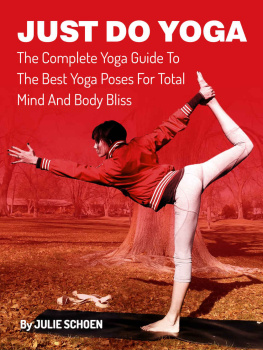YOGA ANATOMY KEYS
The Functional Guide for Beginners
By
Holly Emily Walker
Copyright 2019 by HOLLY EMILY WALKER All rights reserved .
This document is geared towards providing exact and reliable information with regard to the topic and issue covered. The publication is sold with the idea that the publisher is not required to render accounting, officially permitted, or otherwise, qualified services. If advice is necessary, legal or professional, a practiced individual in the profession should be ordered.
From a Declaration of Principles, which was accepted and approved equally by a Committee of the American Bar Association and a Committee of Publishers and Associations.
In no way is it legal to reproduce, duplicate, or transmit any part of this document in either electronic means or printed format. Recording of this publication is strictly prohibited and any storage of this document is not allowed unless with written permission from the publisher. All rights reserved.
The information provided herein is stated to be truthful and consistent, in that any liability, in terms of inattention or otherwise, by any usage or abuse of any policies, processes, or directions contained within is the solitary and utter responsibility of the recipient reader. Under no circumstances will any legal responsibility or blame be held against the publisher for any reparation, damages, or monetary loss due to the information herein, either directly or indirectly.
Respective authors own all copyrights not held by the publisher.
The information herein is offered for informational purposes solely and is universal as so. The presentation of the information is without a contract or any type of guarantee assurance.
The trademarks that are used are without any consent, and the publication of the trademark is without permission or backing by the trademark owner. All trademarks and brands within this book are for clarifying purposes only and are the owned by the owners themselves, not affiliated with this document
DISCLAIMER
This document is geared towards providing exact and suitable information in regards to the topic and issue covered in this book. The publication is sold on the concept that the publisher is not required to render an accounting, officially allowed, or otherwise qualified service. If advice is necessary, legal or professionals, a practiced individual in the profession should be called.
From a Declaration of Principles that was accepted and approved equally by a Committee of the American Bar Association and a Committee of Publishers and Associations.
In no way is it legal to reproduce, duplicate, from, or transmit any part of this document by either a printed format or electronic means. Recording of this publication is highly prohibited, and any storage of this document is not allowed unless with written permission from the publisher. All rights reserved.
The information provided herein is stated to be truthful and consistent, in that any liability, in terms of inattention or otherwise, by any usage or abuse of any policies, processes, or directions contained within is the solitary and utter responsibility of the recipient reader. Under no circumstances will any legal responsibility or blame be held against the publisher for any reparation, damages, or monetary loss due to the information herein, either directly or indirectly.
The respective author owns all copyrights not held by the publisher.
The information herein is offered for informational purposes solely and is universal as so.
The presentation of the information is without a contract or any type of guarantee assurance.
The trademarks that are used are without any consent, and the publication of the trademark is without permission or backing by the trademark owner. All trademarks and brands within this book are for clarifying purposes only and are owned by the owners themselves, not affiliated with this document.
TABLE OF CONTENTS
DISCLAIMER
Introduction
Chapter 1 - Introduction To Yoga
Chapter 2 - Meaning Of Yoga
Chapter 3 - Benefits Of Yoga
Chapter 4 - Yoga For Everyone
Chapter 5 - Yoga And Meditation
Chapter 6 - Why Is Breathing So Important In Yoga?
Chapter 7 - Yoga Meditation
Chapter 8 - The Spiritual, Mental, And Self-discipline Benefits Of Yoga
Chapter 9 - Conclusion
Introduction
Yoga is now regarded in the Western world as a holistic approach to health and is classified by the National Institutes of Health as a form of Complementary and Alternative Medicine (CAM). The word "Yoga" comes from a Sanskrit root "Yuj," which means union, it direct and concentrate one's attention. The regular practice of yoga promotes strength, endurance, flexibility, and facilitates characteristics of friendliness, compassion, and greater self-control while cultivating a sense of calmness and well-being. The result of continuous yoga practice leads to changes in life perspective, self-awareness, and an improved understanding of energy to live life fully and with genuine enjoyment. The constant practice of yoga produces a physiological state opposite to that of the fight stress response, and with that interruption in the stress response, a sense of balance and union between the mind and body will be achieved.
Yoga is a form of mind-body fitness that involves the combination of muscular activity while an internally directed mindful focus on awareness of the self, the breath, and energy. Four basic principles control the teachings and practices of yoga's healing system.
The first principle is the human body, which is a holistic entity comprised of various interrelated dimensions that are not separable from one another while the health or illness of any of this dimension affects the other aspects.
The second principle is individuals and their needs, which are different and must be approached in a way that acknowledges this individuality.
The third principle is yoga is self-empowering; the student is his or her healer. Yoga engages the student in the healing process, the students an active role in their journey toward their health, the healing comes from within, instead of from an outside source.
The fourth principle is that the quality and state of an individual's mind. The mind of an individual is crucial to healing. When the individual has positive mind-state healing happens more quickly, whereas if the mind-state is negative, healing may be prolonged.
Patanjali first described yoga philosophy and practice in the classic text, Yoga Sutras , which is widely acknowledged as the authoritative text on yoga. Today, many people identify yoga by the physical practice of Yoga (asana), but asana is just one of the many tools used for healing the individual; only three of the 196 sutras mention asana, and the remainder of the text discusses the other components of yoga including conscious breathing, meditation, lifestyle and diet changes, visualization and the use of sound, among many others
The eight limbs are comprised of ethical principles for living a meaningful and purposeful life, serving as a prescription for moral and ethical conduct and self-discipline; they direct attention towards one's health while acknowledging the spiritual aspects of one's nature. Any of the eight limbs may be used separately, but within yoga philosophy, the physical postures and breathing exercises prepare the mind and body for meditation and spiritual development. Based on Patanjali's eight limbs, many different yogic disciplines have been developed. Each has its technique for preventing and treating disease. The most common aspects of yoga practiced are the physical postures and breathing practices of Hatha Yoga and meditation.

















